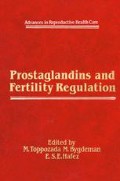Abstract
The human cervix can today be considered as a separate functional entity within the uterus in comparison with an earlier widespread opinion that this structure merely played a passive role secondarily to contractions of the uterine body. This new view is based upon investigations demonstrating that hormones and Prostaglandins are able to interfere with cervical connective tissue independently of myometrial activity (Schild et al., 1951; Novy and Liggins, 1980). Thus, Prostaglandins of both E- and F-series have been shown, in clinical studies, to act on the cervix apart from their effect on the myometrium (MacLennan and Green, 1979; Ulmsten, 1979; Forman et al., 1982). From these and other studies from our laboratory (Norström et al., 1981; Norström, 1982), it seems reasonable to suggest that PGs act directly on the fibrous connective tissue, which constitutes the major part of the cervix (Danforth, 1974; Hughesdon, 1952).
Access this chapter
Tax calculation will be finalised at checkout
Purchases are for personal use only
Preview
Unable to display preview. Download preview PDF.
References
Brody, M. J. and Kadowitz, P. J. (1974). Prostaglandins as modulators of the anatomic nervous system. Fed. Proc., 33, 48–60
Danforth, D. N. (1974). The fibrous nature of the human cervix, and its relation to the isthmic segment in gravid and nongravid uteri. Am. J. Obstet. Gynecol., 53, 541–560
Forman, A., Ulmsten, U., Bányai, J., Wingerup, L. and Uldbjerg, N. (1982). Evidence for a local effect of intracervical Prostaglandin E2-gel. Am. J. Obstet. Gynecol., 143, 756–760
Hedqvist, P. (1970). Studies on the effect of Prostaglandin E1 and E2 in the sympathetic neuromuscular transmission in some animal tissues. Acta Physiol. Scand., Suppl. 345, p. 1
Hughesdon, M. K. (1952). The fibromuscular structure of the cervix and its changes during pregnancy and labour. J. Obstet. Gynecol. Br. Emp., 59, 765–776
Lowry, O. H., Rosebrough, R., Farr, A. L. and Randall, J. (1951). Protein measurement with the folin phenol reagent. J. Biol. Chem., 193, 265–275
MacLennan, A. H. and Green, R. C. (1979). Cervical ripening and induction of labour with intravaginal Prostaglandin F2α. Lancet, 1, 117–119
Norström, A. (1982). Influence of Prostaglandin E2 on the biosynthesis of connective tissue constituents on the pregnant human cervix. Prostaglandins, 23, 361–368
Norström, A., Wilhelmsson, L. and Hamberger, L. (1981). The regulatory influence of Prostaglandin on protein synthesis in the human non-pregnant cervix. Prostaglandins, 22, 117–123
Novy, M. J. and Liggins, G. C. (1980). Role of Prostaglandins, prostacyclin and thromboxane in the physiological control of the uterus and in parturition. Semin. Perinat., 4, 45–66
Owman, Ch., Sjöberg, N. O. and Sjöstrand, N. O. (1974). Short adrenergic neurons, a peripheral neuro-endocrine mechanism, In Fujwara, M. and Tanaka, C. (eds.) Amino Fluorescence Histochemistry. pp. 47–66. ( Tokyo: Igaku Shoin )
Owman, Ch., Alm., P., Rosengren, E., Sjöberg, N. O. and Thorbert, G. (1975). Variation in the level of uterine norepinephrine during pregnancy in the guinea pig. Am J. Obstet. Gynecol., 122, 961–964
Schild, H. O., Fitzpatrick, R. J. and Nixon, W. C. W. (1951). Activity of the human cervix and corpus uteri. Lancet, 260, 250–253
Sjöberg, N. O. (1968). Considerations on the cause of disappearance of the adrenergic transmitter in uterine nerves during pregnancy. Acta Physiol. Scand., 72, 510–517
Thorbert, G. (1978). Regional changes in structure and function of adrenergic nerves in guinea pig uterus during pregnancy. Acta Obstet. Gynecol. Scand., Suppl. 79, p. 000
Ulmsten, U. (1979). Aspects on ripening of the cervix and induction of labour by intracervical application of PGE2 in viscous gel. Acta Obstet. Gynecoi. Scand., Suppl. 184, pp. 5–9
Editor information
Editors and Affiliations
Rights and permissions
Copyright information
© 1984 MTP Press Limited
About this chapter
Cite this chapter
Wilhelmsson, L., Norström, A., Tjugum, J., Hamberger, L. (1984). Interaction between prostaglandins and catecholamines on cervical collagen. In: Toppozada, M.K., Bygdeman, M., Hafez, E.S.E. (eds) Prostaglandins and Fertility Regulation. Advances in Reproductive Health Care, vol 4. Springer, Dordrecht. https://doi.org/10.1007/978-94-009-5600-1_6
Download citation
DOI: https://doi.org/10.1007/978-94-009-5600-1_6
Publisher Name: Springer, Dordrecht
Print ISBN: 978-94-010-8969-2
Online ISBN: 978-94-009-5600-1
eBook Packages: Springer Book Archive

